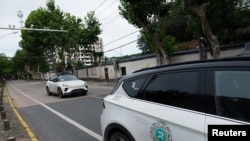Liu Yi is among China's 7 million ride-hailing drivers. A 36-year-old Wuhan resident, he started driving part-time this year when construction work slowed in the face of a nationwide glut of unsold apartments.
Now he predicts another crisis as he stands next to his car watching neighbors order driverless taxis.
"Everyone will go hungry," he said of Wuhan drivers competing against robotaxis from Apollo Go, a subsidiary of technology giant Baidu 9888.HK.
Baidu and the Ministry of Industry and Information Technology declined comment.
Ride-hailing and taxi drivers are among the first workers globally to face the threat of job loss from artificial intelligence as thousands of robotaxis hit Chinese streets, economists and industry experts said.
Self-driving technology remains experimental but China has moved aggressively to green-light trials compared with the U.S which is quick to launch investigations and suspend approvals after accidents.
At least 19 Chinese cities are running robotaxi and robobus tests, disclosure showed. Seven have approved tests without human-driver monitors by at least five industry leaders: Apollo Go, Pony.ai, WeRide, AutoX and SAIC Motor 600104.SS.
Apollo Go has said it plans to deploy 1,000 in Wuhan by year-end and operate in 100 cities by 2030.
Pony.ai, backed by Japan's Toyota Motor 7203.T, operates 300 robotaxis and plans 1,000 more by 2026. Its vice president has said robotaxis could take five years to become sustainably profitable, at which point they will expand "exponentially."
WeRide is known for autonomous taxis, vans, buses and street sweepers. AutoX, backed by e-commerce leader Alibaba Group 9988.HK, operates in cities including Beijing and Shanghai. SAIC has been operating robotaxis since the end of 2021.
"We've seen an acceleration in China. There's certainly now a rapid pace of permits being issued," said Boston Consulting Group managing director Augustin Wegscheider. "The U.S. has been a lot more gradual."
Alphabet's GOOGL.O Waymo is the only U.S. firm operating uncrewed robotaxis that collect fares. It has over 1,000 cars in San Francisco, Los Angeles and Phoenix but could grow to "thousands," said a person with knowledge of its operations.
Cruise, backed by General Motors GM.N, restarted testing in April after one of its vehicles hit a pedestrian last year.
Cruise said it operates in three cities with safety its core mission. Waymo did not respond to a request for comment.
"There's a clear contrast between U.S. and China" with robotaxi developers facing far more scrutiny and higher hurdles in the U.S., said former Waymo CEO John Krafcik.
Robotaxis spark safety concerns in China, too, but fleets proliferate as authorities approve testing to support economic goals. Last year, President Xi Jinping called for "new productive forces," setting off regional competition.
Beijing announced testing in limited areas in June and Guangzhou said this month it would open roads citywide to self-driving trials.
Some Chinese firms have sought to test autonomous cars in the U.S. but the White House is set to ban vehicles with China-developed systems, said people briefed on the matter.
Boston Consulting's Wegscheider compared China's push to develop autonomous vehicles to its support of electric vehicles.
"Once they commit," he said, "they move pretty fast."
'Stupid radishes'
China has 7 million registered ride-hailing drivers versus 4.4 million two years ago, official data showed. With ride-hailing providing last-resort jobs during economic slowdown, the side effects of robotaxis could prompt the government to tap the brakes, economists said.
In July, discussion of job loss from robotaxis soared to the top of social media searches with hashtags including, "Are driverless cars stealing taxi drivers' livelihoods?"
In Wuhan, Liu and other ride-hailing drivers call Apollo Go vehicles "stupid radishes" - a pun on the brand's name in local dialect - saying they cause traffic jams.
Liu worries, too, about the impending introduction of Tesla's TSLA.O "Full Self-Driving" system - which still requires human drivers - and the automaker's robotaxi ambitions.
"I'm afraid that after the radishes come," he said, "Tesla will come."
Wuhan driver Wang Guoqiang, 63, sees a threat to workers who can least afford disruption.
"Ride-hailing is work for the lowest class," he said, as he watched an Apollo Go vehicle park in front of his taxi. "If you kill off this industry, what is left for them to do?"
Baidu declined to comment on the drivers' concerns and referred Reuters to comments in May by Chen Zhuo, Apollo Go's general manager. Chen said the firm would become "the world's first commercially profitable" autonomous-driving platform.
Apollo Go loses almost $11,000 a car annually in Wuhan, Haitong International Securities estimated. A lower-cost model could enable per-vehicle annual profit of nearly $16,000, the securities firm said. By contrast, a ride-hailing car earns about $15,000 total for the driver and platform.
'Already at the forefront'
Automating jobs could benefit China in the long run given a shrinking population, economists said.
"In the short run, there must be a balance in speed between the creation of new jobs and the destruction of old jobs," said Tang Yao, associate professor of applied economics at Peking University. "We do not necessarily need to push at the fastest speed, as we are already at the forefront."
Eastern Pioneer Driving School 603377.SS has more than halved its instructor number since 2019 to about 900. Instead, it has teachers at a Beijing control center remotely monitoring students in 610 cars equipped with computer instruction tools.
Computers score students on every wheel turn and brake tap, and virtual reality simulators coach them on navigating winding roads. Massive screens provide real-time analysis of driver tasks, such as one student's 82% parallel-parking pass rate.
Zhang Yang, the school's intelligent-training director, said the machines have done well.
"The efficiency, pass rate and safety awareness have greatly improved."












